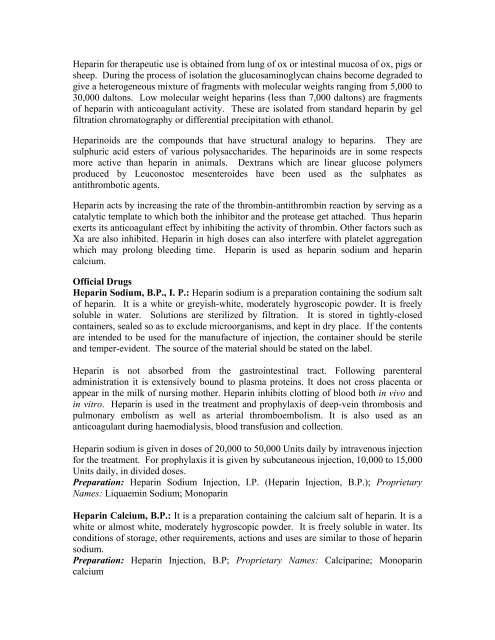MEDICINAL CHEMISTRY
MEDICINAL CHEMISTRY
MEDICINAL CHEMISTRY
Create successful ePaper yourself
Turn your PDF publications into a flip-book with our unique Google optimized e-Paper software.
Heparin for therapeutic use is obtained from lung of ox or intestinal mucosa of ox, pigs or<br />
sheep. During the process of isolation the glucosaminoglycan chains become degraded to<br />
give a heterogeneous mixture of fragments with molecular weights ranging from 5,000 to<br />
30,000 daltons. Low molecular weight heparins (less than 7,000 daltons) are fragments<br />
of heparin with anticoagulant activity. These are isolated from standard heparin by gel<br />
filtration chromatography or differential precipitation with ethanol.<br />
Heparinoids are the compounds that have structural analogy to heparins. They are<br />
sulphuric acid esters of various polysaccharides. The heparinoids are in some respects<br />
more active than heparin in animals. Dextrans which are linear glucose polymers<br />
produced by Leuconostoc mesenteroides have been used as the sulphates as<br />
antithrombotic agents.<br />
Heparin acts by increasing the rate of the thrombin-antithrombin reaction by serving as a<br />
catalytic template to which both the inhibitor and the protease get attached. Thus heparin<br />
exerts its anticoagulant effect by inhibiting the activity of thrombin. Other factors such as<br />
Xa are also inhibited. Heparin in high doses can also interfere with platelet aggregation<br />
which may prolong bleeding time. Heparin is used as heparin sodium and heparin<br />
calcium.<br />
Official Drugs<br />
Heparin Sodium, B.P., I. P.: Heparin sodium is a preparation containing the sodium salt<br />
of heparin. It is a white or greyish-white, moderately hygroscopic powder. It is freely<br />
soluble in water. Solutions are sterilized by filtration. It is stored in tightly-closed<br />
containers, sealed so as to exclude microorganisms, and kept in dry place. If the contents<br />
are intended to be used for the manufacture of injection, the container should be sterile<br />
and temper-evident. The source of the material should be stated on the label.<br />
Heparin is not absorbed from the gastrointestinal tract. Following parenteral<br />
administration it is extensively bound to plasma proteins. It does not cross placenta or<br />
appear in the milk of nursing mother. Heparin inhibits clotting of blood both in vivo and<br />
in vitro. Heparin is used in the treatment and prophylaxis of deep-vein thrombosis and<br />
pulmonary embolism as well as arterial thromboembolism. It is also used as an<br />
anticoagulant during haemodialysis, blood transfusion and collection.<br />
Heparin sodium is given in doses of 20,000 to 50,000 Units daily by intravenous injection<br />
for the treatment. For prophylaxis it is given by subcutaneous injection, 10,000 to 15,000<br />
Units daily, in divided doses.<br />
Preparation: Heparin Sodium Injection, I.P. (Heparin Injection, B.P.); Proprietary<br />
Names: Liquaemin Sodium; Monoparin<br />
Heparin Calcium, B.P.: It is a preparation containing the calcium salt of heparin. It is a<br />
white or almost white, moderately hygroscopic powder. It is freely soluble in water. Its<br />
conditions of storage, other requirements, actions and uses are similar to those of heparin<br />
sodium.<br />
Preparation: Heparin Injection, B.P; Proprietary Names: Calciparine; Monoparin<br />
calcium

















